Poisson Level
This notebook compares the PSD from celerite to the periodogram and determines the noise level
[1]:
import celerite
from celerite.terms import JitterTerm
from mind_the_gaps.models import DampedRandomWalk as DRW
from mind_the_gaps.models import BendingPowerlaw as BPL, SHO, Matern32, Jitter
from mind_the_gaps.simulator import Simulator
import numpy as np
from scipy.optimize import minimize
import matplotlib.pyplot as plt
from stingray import Lightcurve, Powerspectrum
from scipy.stats import ks_1samp, chi2
def neg_log_like(params, y, gp):
gp.set_parameter_vector(params)
return -gp.log_likelihood(y)
cores = 12
[3]:
np.random.seed(42)
Npoints = 1000
times = np.linspace(0, 1000, Npoints) * 3600 * 24 # seconds
exposures = 1000 * np.ones(Npoints) # seconds
duration = times[-1] + 1.5 * exposures[-1] - (times[0])
print("Lightcurve duration: %.2f d" % (duration / 3600 /24))
aliasing_factor = 2
sim_dt = np.min(exposures) / aliasing_factor
logS0 = 0
S0 = np.exp(logS0)
logw0 = -13
w0 = np.exp(logw0)
break_timescale = 1 / (w0 / 2 / np.pi) / 3600 / 24
print("Break timescale: %.2f d" % break_timescale)
psd_model = BPL(S0=S0, omega0=np.exp(-13))
minimum_frequency = 1 / (duration)
maximum_frequency = 1 / (sim_dt)
fnyq = maximum_frequency
extension_factor = 10
df_int = 1 / (duration * extension_factor)
int_freq = np.arange(minimum_frequency, fnyq, df_int) # frequencies over which to integrate
w_int = int_freq * 2 * np.pi
normalization_factor = 2 / np.sqrt(2 * np.pi) # this factor accounts for the fact that we only integrate positive frequencies and the 1 / sqrt(2pi) from the Fourier transform
var = np.sum(psd_model(w_int)) * df_int * 2 * np.pi * normalization_factor
simulator = Simulator(psd_model, times, exposures, mean=0, pdf="Gaussian", extension_factor=extension_factor,
aliasing_factor=aliasing_factor)
lc = simulator.simulate_regularly_sampled()
plt.plot(lc.time, lc.countrate)
plt.gca().ticklabel_format(useOffset=False)
print("Model variance: %.5f" % S0)
print("Integrated variance: %.5f" % var)
print("LC variance: %.5f" % np.var(lc.countrate))
plt.figure()
plt.plot(1 / int_freq / 3600 / 24, psd_model(w_int))
plt.axvline(1 / minimum_frequency/ 3600 / 24, color="green", alpha=0.5, ls="--")
plt.axvline(1 / maximum_frequency / 3600 / 24, alpha=0.5, color="blue")
plt.xscale("log")
plt.yscale("log")
plt.xlabel("Period (d)")
Lightcurve duration: 1000.02 d
Break timescale: 32.17 d
/home/andresgur/anaconda3/lib/python3.9/site-packages/stingray/utils.py:486: UserWarning: SIMON says: Beware! Stingray only supports poisson err_dist at the moment in many methods, and 'gauss' in a few more.
warnings.warn("SIMON says: {0}".format(message), **kwargs)
Model variance: 1.00000
Integrated variance: 0.98043
LC variance: 1.01722
[3]:
Text(0.5, 0, 'Period (d)')
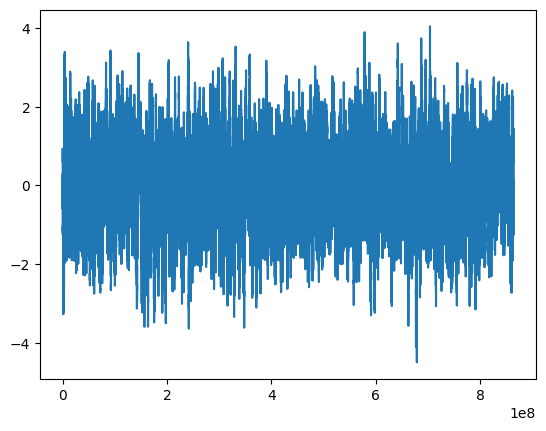
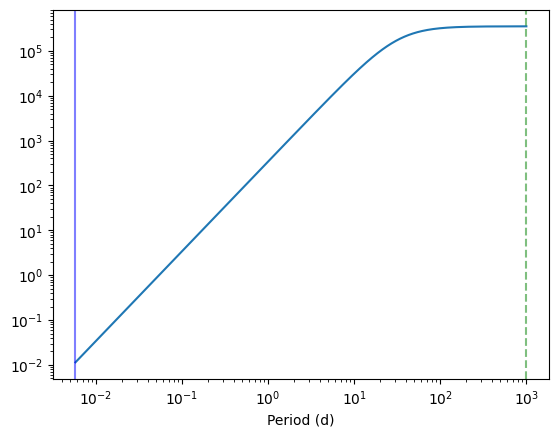
add gaussian noise
[4]:
signoise = 0.5
ynoise = lc.countrate + np.random.normal(0, signoise, size=lc.n)
time = lc.time
# create noisy lightcurve
lc_gauss = Lightcurve(time, counts=ynoise, dt=sim_dt, skip_checks=True, input_counts=False)
y = lc_gauss.countrate
Q = 1/ 2
w0 = 2 * np.pi / (30 * u.d).to(u.s).value
S0 = np.var(lc.countrate)
S_0_N_bounds = (-30, 15)
log_omega0_N_bounds = (-25, -1) # 0 to 200 in period (days)
nwalkers = 12
bounds = dict(log_S0=S_0_N_bounds, log_omega0=log_omega0_N_bounds)
# the second DRW is just to fit the white noise
kernel = DRW(log_S0=np.log(S0), log_omega0=np.log(w0),
bounds=bounds) + JitterTerm(log_sigma=np.log(signoise),
bounds=dict(log_sigma=(-10, 20)))
print(kernel)
fig, axes = plt.subplots(2,1, sharex=True)
axes[0].plot(time, lc.countrate, label="Noiseless")
axes[0].legend()
axes[1].plot(lc_gauss.time, lc_gauss.countrate, label="Gaussian Noise")
axes[1].legend()
(DampedRandomWalk(0.017072777961537826, -12.930063270044956) + JitterTerm(-0.6931471805599453))
[4]:
<matplotlib.legend.Legend at 0x7f5b8c2db7f0>
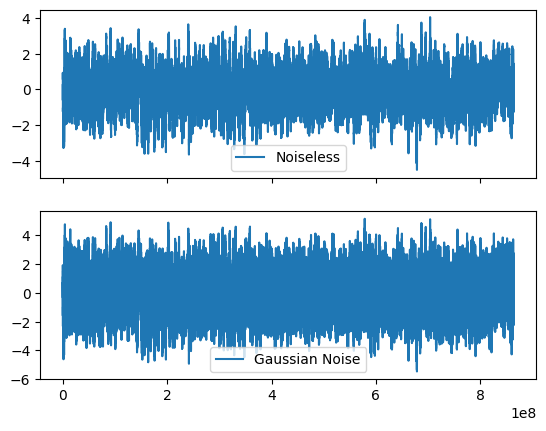
[5]:
gp = celerite.GP(kernel, mean=np.mean(y), fit_mean=False, fit_white_noise=False)
gp.compute(time, yerr=1e-12) # important leave it uncertainty free
initial_params = gp.get_parameter_vector()
solution = minimize(neg_log_like,
initial_params, method="L-BFGS-B", bounds=gp.get_parameter_bounds(),
args=(y, gp))
[6]:
print(gp.parameter_names)
print(solution.x)
df = 1 / (lc.tseg)
fnyq = 1 / (2 * lc.dt)
frequencies = np.arange(df, fnyq, df)
w = frequencies * 2 * np.pi
print(solution.x)
print("Derived sigma: %.2f (Input: %.2f)" % (np.exp(solution.x[-1]), signoise))
gp.set_parameter_vector(solution.x)
# add sigma to PSD
noiselevel = np.ones(len(frequencies)) * 2 * lc.dt * np.exp(solution.x[-1])**2 / (2 * np.pi * normalization_factor)
psd = gp.kernel.get_psd(w) + noiselevel
plt.figure()
plt.plot(frequencies, psd, label="Fit model")
plt.plot(frequencies, noiselevel , label="Jitter")
plt.plot(frequencies, gp.kernel.get_psd(w), label="DRW")
plt.yscale("log")
plt.xscale("log")
plt.plot(frequencies, psd_model(w), label="Input model", ls="--")
print("Ratio ampltiudes")
print(np.exp(solution.x)[0] / np.exp(logS0))
print("Ratio breaks")
print(np.exp(solution.x)[1] / np.exp(logw0))
plt.axhline(2 * lc.dt * signoise**2 / (2 * np.pi * normalization_factor), ls="--", label="Expected Noise")
plt.legend()
('kernel:terms[0]:log_S0', 'kernel:terms[0]:log_omega0', 'kernel:terms[1]:log_sigma', 'mean:value')
[ -0.03484783 -12.96342275 -0.69427256]
[ -0.03484783 -12.96342275 -0.69427256]
Derived sigma: 0.50 (Input: 0.50)
Ratio ampltiudes
0.9657523627905847
Ratio breaks
1.0372544336869347
[6]:
<matplotlib.legend.Legend at 0x7f5b8c43e6a0>
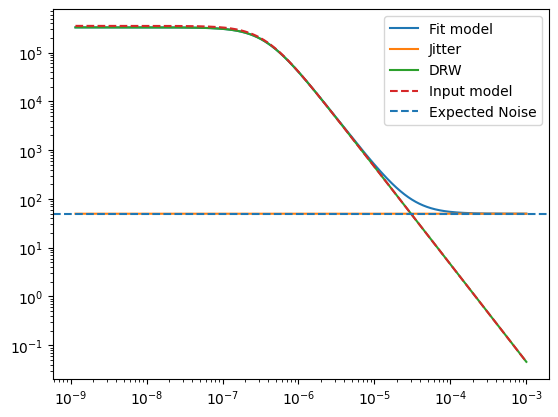
Compute regular periodograms absolute normalization and compare noise normalizations
[7]:
ps = Powerspectrum.from_lightcurve(lc, norm="abs")
ps_gauss = Powerspectrum.from_lightcurve(lc_gauss, norm="abs")
noiseless periodograms
[8]:
log_rb_ps = ps.rebin_log(f=0.3)
plt.plot(log_rb_ps.freq, log_rb_ps.power,
lw=2, color='blue', label="Periodogram")
celerite_renorm = psd_model(w) * 2 * np.pi * normalization_factor
plt.plot(frequencies, celerite_renorm,
label="Celerite (Input Model)", ls="--")
plt.yscale("log")
plt.xscale("log")
# compare results with Chi_2
chi2dist = chi2(2)
plt.figure()
ratio = 2 * ps.power / celerite_renorm
values, bins, _ = plt.hist(ratio, density=False)
plt.hist(chi2dist.rvs(size=len(ps.power)), bins=bins,
edgecolor="pink", facecolor="None")
kstest_res = ks_1samp(ratio, chi2dist.cdf)
print(kstest_res)
KstestResult(statistic=0.0011998821148612726, pvalue=0.16595203833624572, statistic_location=1.2796415995131636, statistic_sign=-1)
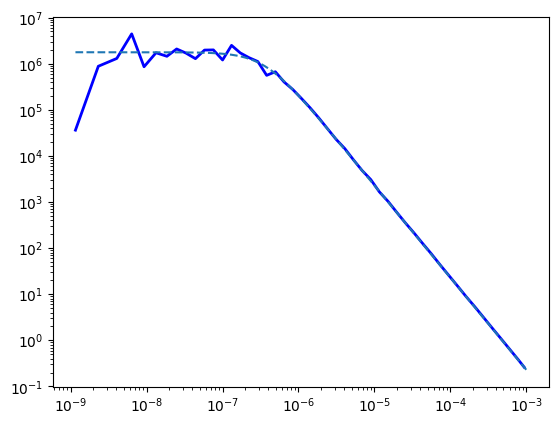
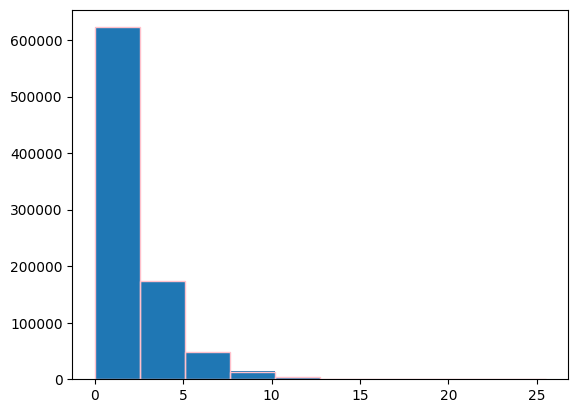
noisy periodogram
[9]:
ps_gauss_rebin = ps_gauss.rebin_log(f=0.3)
plt.plot(ps_gauss_rebin.freq, ps_gauss_rebin.power,
lw=2, color='blue', label="Periodogram")
celerite_renorm = psd * 2 * np.pi * normalization_factor
plt.plot(frequencies, celerite_renorm,
label="Celerite (Fit Model)", ls="--")
plt.yscale("log")
plt.xscale("log")
# noise level
noise = 2 * lc.dt * signoise**2
plt.axhline(noise, ls="--", color="black", label="White Noise")
inferred_noise = 2 * lc.dt * np.exp(solution.x[-1])**2
plt.axhline(inferred_noise, ls=":", color="orange", label="Inferred Noise (Celerite)")
plt.legend()
# compare results with Chi_2
chi2dist = chi2(2)
plt.figure()
ratio = 2 * ps_gauss.power / celerite_renorm
plt.figure()
values, bins, _ = plt.hist(ratio, density=False)
plt.hist(chi2dist.rvs(size=len(ps_gauss.power)), bins=bins,
edgecolor="black", facecolor="None", ls="--")
kstest_res = ks_1samp(ratio, chi2dist.cdf)
print(kstest_res)
KstestResult(statistic=0.001048982883433136, pvalue=0.29750837018111764, statistic_location=2.2891984466176667, statistic_sign=-1)
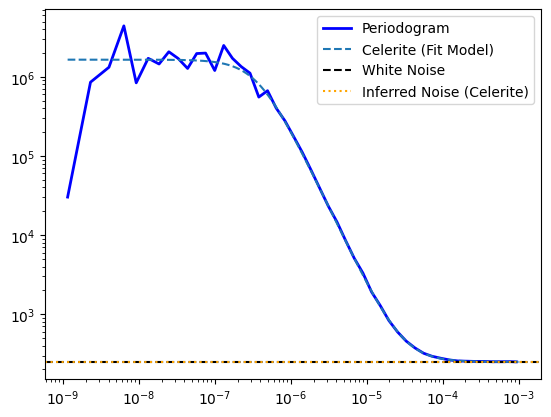
<Figure size 640x480 with 0 Axes>
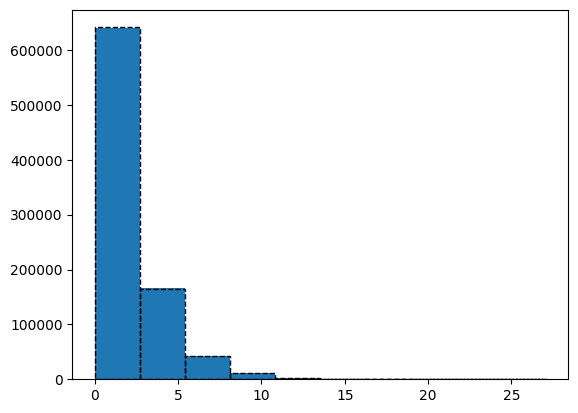
[ ]: